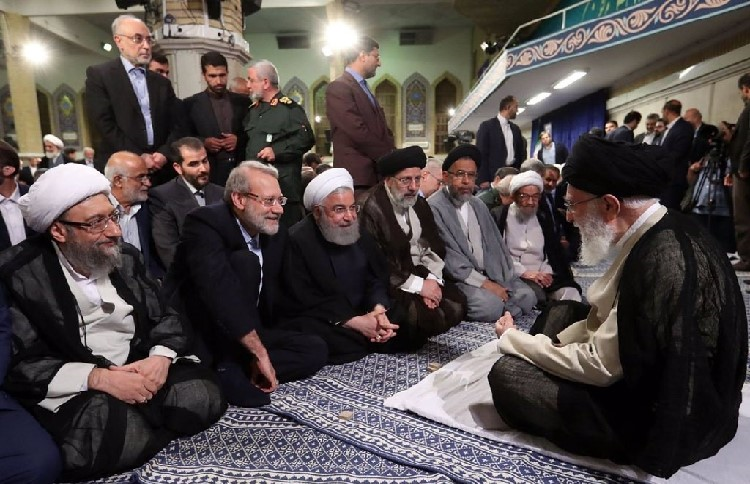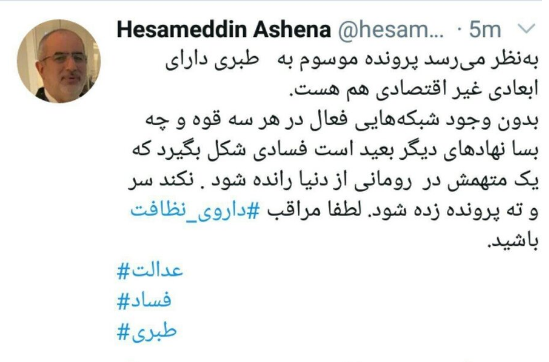
State corruption in Iran has spread its paws among various governmental organizations as well as those affiliated with the ruling elite in the aftermath of the 1979 revolution.
According to the International Transparency Organization’s report of 2020, the Islamic Republic of Iran ranks 146 among 180 countries when it comes to financial corruption, falling eight ranks in comparison with last year.
But in a blatantly dishonest statement on June 2018, Iran’s supreme leader, Ali Khamenei, denied institutionalized corruption in his regime while addressing some students: “I am fully informed that corruption is neither vast nor systematic in our ‘Nezam’ (system). Corruption is a global issue.”
Abusing political power to preserve the regime and acquiring wealth led to an unprecedented growth of corruption in Iran, which broke out under pressures such as vast sanctions, reduction in oil prices, and global economic recession.
Corruption in Iran is completely endemic in Khamenei and other high-ranking officials. In no other country, can you find corruption and plundering in such fields as forestry, land, mines, seas, and even lagoons. Describing the corruption in his regime, Khamenei said on Feb. 8, 2018: “Corruption is like a seven-headed dragon. You cut one head it moves around with six others. It is not easily destroyed.”
The concentration of power and wealth in the hands of the Islamic Revolutionary Guards Corps (IRGC), governmental organs and Khamenei himself, as well as the privilege of the IRGC to enjoy Iran’s assets through political relations are what enables the corruption in Iran.
IRGC’s Khatam al-Anbia construction base is the main center of this octopus for plundering natural resources. The base consists of 50 important economic centers; except seven, all are controlled by the IRGC.
Formation of systematic corruption in Iran:
When organs that are meant to fight corruption are corrupt themselves, then corruption becomes systematic.
In September 2019, Mohammad Yazdi, the secretary of the Qom Clerical School Teachers Community, addressed Sadeq Larijani, the former head of the Judiciary, the current head of Expediency Discernment Council and a member of the Guardian Council, in a letter: “You have built a palace under the name of Clerical School! … Where did you get the money to build it?”
In retaliation, Sadeq Larijani wrote back: “I have been accused by a group of deputies, surrogates, children of our officials, and personalities, and I have kept silent.”
In another instance, in 2019, Gholamreza Mansouri, a judge, reportedly fled Iran after being accused of taking 500,000 euros in bribes. He ran to Germany and then Romania in August of 2019 and was arrested by Interpol on June 14, 2020. The IRGC’s intelligence arm intended to send a private plane to extradite him. Nonetheless, a Romanian court on June 12 postponed the extradition of Mansouri, demanding that Tehran present documents and evidence against the accused.
However, on the afternoon of June 19, the official Romanian news agency reported that Gholamreza Mansouri had thrown himself out of the window of the fifth floor of the hotel of his residence and committed suicide. The Security and Counter-Terrorism Commission of the National Council of Resistance of Iran (NCRI) said in a statement: “All the evidence suggests that Judge Mansouri was killed by the same method that the regime’s intelligence services specialize in.”
The statement added: “Under the pressure of sanctions and the coronavirus epidemic, war within gangs of the regime for the succession of Khamenei has escalated, and new pawns are spent and sacrificed, which In the culture of IRGC and intelligence service of Khamenei, it is called “complex multifaceted operations”.
Hessameddin Ashena, an adviser to Rouhani and the regime’s former deputy intelligence minister, speaking on the Gholamreza Mansouri killing, openly recalled Saeed Emami’s “forced suicide” scenario on his Twitter account.

It should be noted that Saeed Emami is a former official of the Ministry of Intelligence of the Iranian regime and the mastermind of the 1990s’ serial killings committed by the mullahs’ regime and its Ministry of Intelligence.
The regime’s corruption is not constrained inside Iran; on the international level, it manifests itself in money-laundering, evading sanctions, and violating international laws.
On June 13, Alex Saab, a Colombian businessman with close ties to the Venezuelan government was arrested in Cape Verde on his way to Iran when his plane stopped for fuel. He is accused of money-laundering and working with Caracas to deliver nine tons of gold worth $500 million to the Iranian regime for oil. In Latin America, this scandal is roiling the region.
The above-mentioned facts of corruption are just the tip of the iceberg of this corrupt regime.
The people of Iran demonstrated their abhorrence of it during November 2019 uprising when they took into the street in 198 cities.
Though Tehran has found its tools of survival in corruption, suppression, and the export of crises over its borders, all this will form a ladder that will end in its downfall.
- What Is Happening Has Nothing To Do With George Floyd, Or Even Black People
- The Saga Of Putin And Lukashenko


1 comment
I used to be recommended this web site by way
of my cousin. I am not sure whether or not this submit is written by means of him as no
one else know such particular about my difficulty. You’re incredible!
Thank you!